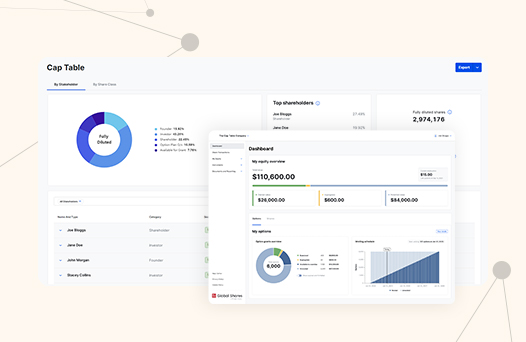Fundraising dos and don’ts with entrepreneur and investor Max Fleitmann
“When I did my first fundraise I shouldn’t have raised money because it wasn’t clear for me what that meant for the longer strategy of the company,” Max Fleitmann founder of BaseTemplates and StudyHelp GmbH tells us.
He joined us to talk honestly and openly about mistakes made, lessons learned and top tips from his over 15 years of experience.
For founders or startups who’re thinking about, or have reached the fundraising stage, figuring out how to choose the right investors to go with and the importance of getting your equity compensation plan set up correctly early in the game, it can feel like you’re moving about in the dark. We want to turn on the lights and show that regardless of the industry investors all ask the same basic questions; how it’s going to work, scale up and generate a return for them.
Raising money – is the time right?
Not everyone needs to raise funds. Think from your company perspective, not your personal perspective, could you have a successful, smaller scale businesses or are you creating one that could potentially become a market leader one day? Can you bootstrap through generating your own revenue early on or are you building something that’s going to take investment, e.g. a technology company? Once you’ve established which path you’re on it’ll help cut through the noise. Remember, raising capital to just pay your bills is the wrong approach.
“When I was first fund raising we had no clue what we were doing and I made the big mistake of not reading enough about it or talking to other people,” Max reveals. “We took the VC funding rather than the acquisition offer. To be honest we were very naive. (Founders need to) create some kind of fundraising plan or strategy.”
“We realized we now had these VC investors and they had this big expectation that growth was the main KPI. More important than everything else,” Max realized too late they should have remained bootstrapped as once started down this path it’s very difficult to get off of as your decision making power becomes diluted. “The moment you get external shareholders on board they have differing opinions you have to hear, then in the end you as a group of shareholders make the decision. It’s no longer just you as an individual anymore.”

“The moment you get external shareholders on board they have differing opinions you have to hear, then in the end you as a group of shareholders make the decision. It’s no longer just you as an individual anymore.”
How much should you raise?
In the early stages many founders struggle because they’ve never built a solid financial plan, aren’t sure where they want to go with the company or exactly how much funds they need to raise has never really been considered. Going from seed to exit is a long journey. There’s no one size fits all solution and success to one person might not look the same to others.
Max advises thinking backwards here. Ask yourself:
- What money do I need to accomplish this 12-18 month goal?
- Who do I need around me to achieve that?
- What sort of skills and inputs do I need to make that happen?
Then build in a buffer.
“Think about the costs of what you’ll need to get to that next stage of growth,” our MD of Emerging Companies, Derek Gallagher also advises. Investors will be looking for evidence that the founders have considered assumptions about customer attraction, customer acquisition costs etc. You can expect to be challenged about these, so have your homework done.
Who do you want to raise from and for how long? It’s a marriage with a planned divorce.
Who you choose to to raise funds from comes with different expectations. Family and friends may be less eager to get a financial return, especially in the early stages, but as you grow you’ll be looking beyond that pool.
Here, we look at Angels, Accelerators and Venture Capitalists.
Angels: Invest their own money. Good for advice since lots of them are/were founders or operators themselves.
Accelerators: Basically a professionalized version of angels. Great for building your network.
Venture Capitalists/VCs. Investing other people’s money so have to really drive high returns and are looking for businesses that can generate these.
“You’re going to be working the next 7/10 years together. The personal component is important,” Max says. “I would never take an investor on board just because of the money. If you are not 100% aligned with the person then you are going to have a hard time every single week. Be sure you get along personally.”
“It’s like a marriage with a planned divorce,” Derek explains. “You’ve got to know what level that VC wants to exit. Know that as part of your due diligence on your investors.”
Making those connections
“I would set up a personal CRM for myself in hour zero because you really have to track all the interactions you have with investors on the one hand, but also potential people you want to hire later on,” is Max’s advice if he were starting over again.
Other founders: Do they have any investors on their cap table they can recommend? A warm introduction comes with a trust factor.
Events: Conferences or local meet ups. Investors are always looking for new people who want to change the world.
Online communities: Like-minded investors, founders or potential new hires who are interested in interacting with each other.
Accelerator Programs: These are your peers and long-term connections are forged here.
Use outside input as a chance to adapt, make changes and choices that you would never have considered before.
Managing your Cap Table
Max recommends not trying to reinvent the wheel. “Use a common structure for how the cap table is split. Don’t start with any experiments on that because it will give you a hard time later. It should be as evenly distributed among co-founders as possible and don’t start with any debt capital in your cap table.”
Always be thinking about what exits from the cap table look like, who you want on it in 18 months’ time and, in terms of equity split and vesting periods, have these discussions early on and openly with your co-founders.
Equity Compensation as a tool to attract talent
VCs and investors will expect you to have an equity plan in place to attract and reward staff. Your employees are the ones who’ll help get you where you need to go so you should be setting aside 10% to 20% for attracting talent. At this stage you have more flexibility for rewarding your staff. Use it to your advantage.
“You need the best people that you can get your hands on. There are people who want to be part of it and are open to taking the risk, but they want the benefit, the reward that comes from taking that risk. VCs know that,” Derek advises.
What does an exit look like?
“Don’t build a business for an exit case, build a business because it’s a great business” Max says as he and Derek discuss how this goes back to whether you’re building a lifestyle business or not. In some instances there may be no exit while in others you’ll need to have conversations around succession planning,
“It’s suddenly a life changing amount of money for you to get in your pocket. A lot of (first-time) founders sell their business too early and this is something that investors don’t like because the big returns come later,” Max explains. “It’s important to do some secondary deals and make the secondary market more liquid and keep some of the cash behind a firewall.”
Key Takeaways from Max
- Clarity of vision
- Strong relationships and connections
- Populate your cap table with the right people
- Create your own milestones
- Plan but prepare for change
- Have the right exit plan
“If something isn’t working then adapt quickly and try something else. But don’t spend on stupid stuff like a fancy office or company swag or tv commercials,” Max concludes.
“Your journey as an entrepreneur will be really hard. I have never seen a successful business that only has good times.”
Talk to us
If you want to learn more about how you can leverage your cap table to attract the right investor, get in touch today.
Please Note: This publication contains general information only and J.P. Morgan Workplace Solutions is not, through this article, issuing any advice, be it legal, financial, tax-related, business-related, professional or other. J.P. Morgan Workplace Solutions’ Insights is not a substitute for professional advice and should not be used as such. J.P. Morgan Workplace Solutions does not assume any liability for reliance on the information provided herein.



